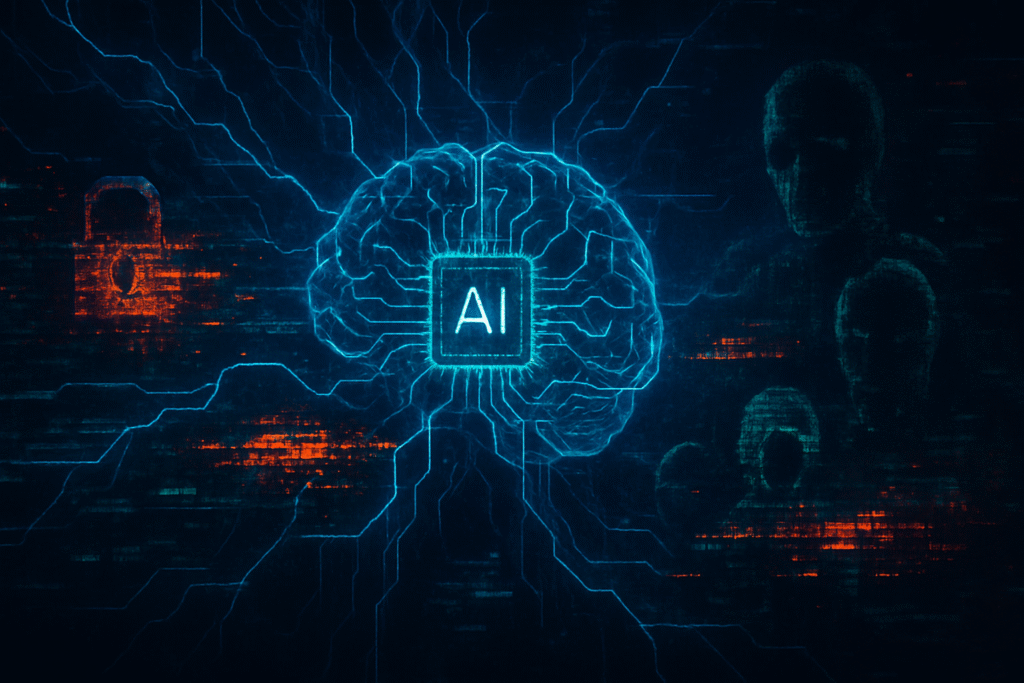
October 16, 2025 – The digital battleground has been irrevocably reshaped by artificial intelligence, as state-sponsored groups and independent malicious actors alike are leveraging advanced AI capabilities to orchestrate cyberattacks of unprecedented sophistication and scale. Reports indicate a dramatic surge in AI-powered campaigns, with nations such as Russia, China, Iran, and North Korea intensifying their digital assaults on the United States, while a broader ecosystem of hackers employs AI to steal credentials and gain unauthorized access at an alarming rate. This escalating threat marks a critical juncture in cybersecurity, demanding a fundamental re-evaluation of defensive strategies as AI transforms both the offense and defense in the digital realm.
The immediate significance of this AI integration is profound: traditional cybersecurity measures are increasingly outmatched by dynamic, adaptive AI-driven threats. The global cost of cybercrime is projected to soar, underscoring the urgency of this challenge. As AI-generated deception becomes indistinguishable from reality and automated attacks proliferate, the cybersecurity community faces a defining struggle to protect critical infrastructure, economic stability, and national security from a rapidly evolving adversary.
The Technical Edge: How AI Elevates Cyber Warfare
The technical underpinnings of these new AI-powered cyberattacks reveal a significant leap in offensive capabilities. AI is no longer merely an auxiliary tool but a core component enabling entirely new forms of digital warfare and crime.
One of the most concerning advancements is the rise of sophisticated deception. Generative AI models are being used to create hyper-realistic deepfakes, including digital clones of senior government officials, which can be deployed in highly convincing social engineering attacks. Poorly worded phishing emails, a traditional tell-tale sign of malicious intent, are now seamlessly translated into fluent, contextually relevant English, making them virtually indistinguishable from legitimate communications. Iranian state-affiliated groups, for instance, have been actively seeking AI assistance to develop new electronic deception methods and evade detection.
AI is also revolutionizing reconnaissance and vulnerability research. Attackers are leveraging AI to rapidly research companies, intelligence agencies, satellite communication protocols, radar technology, and publicly reported vulnerabilities. North Korean hackers have specifically employed AI to identify experts on their country's military capabilities and to pinpoint known security flaws in systems. Furthermore, AI assists in malware development and automation, streamlining coding tasks, scripting malware functions, and even developing adaptive, evasive polymorphic malware that can self-modify to bypass signature-based antivirus solutions. Generative AI tools are readily available on the dark web, offering step-by-step instructions for developing ransomware and other malicious payloads.
The methods for unauthorized access have also grown more insidious. North Korea has pioneered the use of AI personas to create fake American identities, which are then used to secure remote tech jobs within US organizations. This insider access is subsequently exploited to steal secrets or install malware. In a critical development, China-backed hackers maintained long-term unauthorized access to systems belonging to F5, Inc. (NASDAQ: FFIV), a leading application delivery and security company. This breach, discovered in October 2025, resulted in the theft of portions of the BIG-IP product’s source code and details about undisclosed security flaws, prompting an emergency directive from the US Cybersecurity and Infrastructure Security Agency (CISA) due to the "significant cyber threat" it posed to federal networks utilizing F5 products. Russian state hackers, meanwhile, have employed sophisticated cyberespionage campaigns, manipulating system certificates to disguise their activities as trusted applications and gain diplomatic intelligence.
Beyond state actors, other malicious actors are driving an explosive rise in credential theft. The first half of 2025 saw a staggering 160% increase in compromised credentials, with 1.8 billion logins stolen. This surge is fueled by AI-powered phishing and the proliferation of "malware-as-a-service" (MaaS) offerings. Generative AI models, such as advanced versions of GPT-4, enable the rapid creation of hyper-personalized, grammatically flawless, and contextually relevant phishing emails and messages at unprecedented speed and scale. Deepfake technology has also become a cornerstone of organized cybercrime, with deepfake vishing (voice phishing) surging over 1,600% in the first quarter of 2025. Criminals use synthetic audio and video clones to impersonate CEOs, CFOs, or family members, tricking victims into urgent money transfers or revealing sensitive information. Notable incidents include a European energy conglomerate losing $25 million due to a deepfake audio clone of their CFO and a British engineering firm losing a similar amount after a deepfake video call impersonating their CFO. These deepfake services are now widely available on the dark web, democratizing advanced attack capabilities for less-experienced hackers through "cybercrime-as-a-service" models.
Competitive Implications for the Tech Industry
The escalating threat of AI-powered cyberattacks presents a complex landscape of challenges and opportunities for AI companies, tech giants, and startups. While the immediate impact is a heightened security risk, it also catalyzes innovation in defensive AI.
Cybersecurity firms specializing in AI-driven threat detection and response stand to benefit significantly. Companies like Palo Alto Networks (NASDAQ: PANW), CrowdStrike Holdings, Inc. (NASDAQ: CRWD), and Fortinet, Inc. (NASDAQ: FTNT) are already heavily invested in AI and machine learning to identify anomalies, predict attacks, and automate responses. This new wave of AI-powered attacks will accelerate the demand for their advanced solutions, driving growth in their enterprise-grade offerings. Startups focusing on niche areas such as deepfake detection, behavioral biometrics, and sophisticated anomaly detection will also find fertile ground for innovation and market entry.
For major AI labs and tech companies like Microsoft Corp. (NASDAQ: MSFT), Alphabet Inc. (NASDAQ: GOOGL), and International Business Machines Corp. (NYSE: IBM), the competitive implications are twofold. On one hand, they are at the forefront of developing the very AI technologies being weaponized, placing a significant responsibility on them to implement robust safety and ethical guidelines for their models. OpenAI, for instance, has already confirmed attempts by state-affiliated groups to misuse its AI chatbot services. On the other hand, these tech giants possess the resources and expertise to develop powerful defensive AI tools, integrating them into their cloud platforms, operating systems, and enterprise security suites. Their ability to secure their own AI models against adversarial attacks and to provide AI-powered defenses to their vast customer bases will become a critical competitive differentiator.
The development of AI-powered attacks also poses a significant disruption to existing products and services, particularly those relying on traditional, signature-based security. Legacy systems are increasingly vulnerable, necessitating substantial investment in upgrades or complete overhauls. Companies that fail to adapt their security posture will face increased risks of breaches, reputational damage, and financial losses. This creates a strong market pull for innovative AI-driven security solutions that can proactively identify and neutralize sophisticated threats.
In terms of market positioning and strategic advantages, companies that can demonstrate a strong commitment to AI safety, develop transparent and explainable AI defenses, and offer comprehensive, adaptive security platforms will gain a significant edge. The ability to leverage AI not just for threat detection but also for automated incident response, threat intelligence analysis, and even proactive threat hunting will be paramount. This situation is fostering an intense "AI arms race" where the speed and effectiveness of AI deployment in both offense and defense will determine market leadership and national security.
The Wider Significance: An AI Arms Race and Societal Impact
The escalating threat of AI-powered cyberattacks fits squarely into the broader AI landscape as a critical and concerning trend: the weaponization of advanced artificial intelligence. This development underscores the dual-use nature of AI technology, where innovations designed for beneficial purposes can be repurposed for malicious intent. It highlights an accelerating AI arms race, where nation-states and criminal organizations are investing heavily in offensive AI capabilities, forcing a parallel and equally urgent investment in defensive AI.
The impacts are far-reaching. Economically, the projected global cost of cybercrime reaching $24 trillion by 2027 is a stark indicator of the financial burden. Businesses face increased operational disruptions, intellectual property theft, and regulatory penalties from data breaches. Geopolitically, the use of AI by state-sponsored groups intensifies cyber warfare, blurring the lines between traditional conflict and digital aggression. Critical infrastructure, from energy grids to financial systems, faces unprecedented exposure to outages and sabotage, with severe societal consequences.
Potential concerns are manifold. The ability of AI to generate hyper-realistic deepfakes erodes trust in digital information and can be used for widespread disinformation campaigns, undermining democratic processes and public discourse. The ease with which AI can be used to create sophisticated phishing and social engineering attacks increases the vulnerability of individuals, leading to identity theft, financial fraud, and emotional distress. Moreover, the increasing autonomy of AI in attack vectors raises questions about accountability and control, particularly as AI-driven malware becomes more adaptive and evasive. The targeting of AI models themselves through prompt injection or data poisoning introduces novel attack surfaces and risks, threatening the integrity and reliability of AI systems across all sectors.
Comparisons to previous AI milestones reveal a shift from theoretical advancements to practical, often dangerous, applications. While early AI breakthroughs focused on tasks like image recognition or natural language processing, the current trend showcases AI's mastery over human-like deception and complex strategic planning in cyber warfare. This isn't just about AI performing tasks better; it's about AI performing malicious tasks with human-level cunning and machine-level scale. It represents a more mature and dangerous phase of AI adoption, where the technology's power is being fully realized by adversarial actors. The speed of this adoption by malicious entities far outpaces the development and deployment of robust, standardized defensive measures, creating a dangerous imbalance.
Future Developments: The Unfolding Cyber Landscape
The trajectory of AI-powered cyberattacks suggests a future defined by continuous innovation in both offense and defense, posing significant challenges that demand proactive solutions.
In the near-term, we can expect an intensification of the trends already observed. Deepfake technology will become even more sophisticated and accessible, making it increasingly difficult for humans to distinguish between genuine and synthetic media in real-time. This will necessitate the widespread adoption of advanced deepfake detection technologies and robust authentication mechanisms beyond what is currently available. AI-driven phishing and social engineering will become hyper-personalized, leveraging vast datasets to craft highly effective, context-aware lures that exploit individual psychological vulnerabilities. The "malware-as-a-service" ecosystem will continue to flourish, democratizing advanced attack capabilities for a wider array of cybercriminals.
Long-term developments will likely see the emergence of highly autonomous AI agents capable of orchestrating multi-stage cyberattacks with minimal human intervention. These agents could conduct reconnaissance, develop custom exploits, penetrate networks, exfiltrate data, and even adapt their strategies in real-time to evade detection. The concept of "AI vs. AI" in cybersecurity will become a dominant paradigm, with defensive AI systems constantly battling offensive AI systems in a perpetual digital arms race. We might also see the development of AI systems specifically designed to probe and exploit weaknesses in other AI systems, leading to a new class of "AI-native" vulnerabilities.
Potential applications and use cases on the horizon for defensive AI include predictive threat intelligence, where AI analyzes global threat data to anticipate future attack vectors; self-healing networks that can automatically detect, isolate, and remediate breaches; and AI-powered cyber-physical system protection for critical infrastructure. AI could also play a crucial role in developing "digital immune systems" for organizations, constantly learning and adapting to new threats.
However, significant challenges need to be addressed. The explainability of AI decisions in both attack and defense remains a hurdle; understanding why an AI flagged a threat or why an AI-driven attack succeeded is vital for improvement. The ethical implications of deploying autonomous defensive AI, particularly concerning potential false positives or unintended collateral damage, require careful consideration. Furthermore, the sheer volume and velocity of AI-generated threats will overwhelm human analysts, emphasizing the need for highly effective and trustworthy automated defenses. Experts predict that the sophistication gap between offensive and defensive AI will continue to fluctuate, but the overall trend will be towards more complex and persistent threats, requiring continuous innovation and international cooperation to manage.
Comprehensive Wrap-Up: A Defining Moment in AI History
The current surge in AI-powered cyberattacks represents a pivotal moment in the history of artificial intelligence, underscoring its profound and often perilous impact on global security. The key takeaways are clear: AI has become an indispensable weapon for both state-sponsored groups and other malicious actors, enabling unprecedented levels of deception, automation, and unauthorized access. Traditional cybersecurity defenses are proving inadequate against these dynamic threats, necessitating a radical shift towards AI-driven defensive strategies. The human element remains a critical vulnerability, as AI-generated scams become increasingly convincing, demanding heightened vigilance and advanced training.
This development's significance in AI history cannot be overstated. It marks the transition of AI from a tool of innovation and convenience to a central player in geopolitical conflict and global crime. It highlights the urgent need for responsible AI development, robust ethical frameworks, and international collaboration to mitigate the risks associated with powerful dual-use technologies. The "AI arms race" is not a future prospect; it is a current reality, reshaping the cybersecurity landscape in real-time.
Final thoughts on the long-term impact suggest a future where cybersecurity is fundamentally an AI-versus-AI battle. Organizations and nations that fail to adequately invest in and integrate AI into their defensive strategies will find themselves at a severe disadvantage. The integrity of digital information, the security of critical infrastructure, and the trust in online interactions are all at stake. This era demands a holistic approach, combining advanced AI defenses with enhanced human training and robust policy frameworks.
What to watch for in the coming weeks and months includes further emergency directives from cybersecurity agencies, increased public-private partnerships aimed at sharing threat intelligence and developing defensive AI, and accelerated investment in AI security startups. The legal and ethical debates surrounding autonomous defensive AI will also intensify. Ultimately, the ability to harness AI for defense as effectively as it is being weaponized for offense will determine the resilience of our digital world.
This content is intended for informational purposes only and represents analysis of current AI developments.
TokenRing AI delivers enterprise-grade solutions for multi-agent AI workflow orchestration, AI-powered development tools, and seamless remote collaboration platforms.
For more information, visit https://www.tokenring.ai/.





